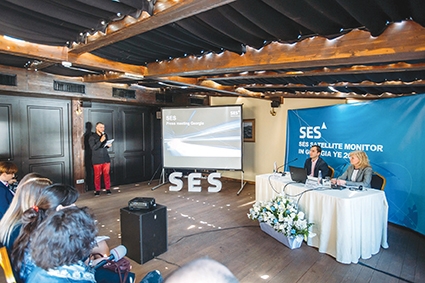SES Presents Satellite Monitor Results in Georgia
World leading satellite operator SES presented the results of its annual market research study, at a presentation for the press held in the Museum Hotel Tbilisi this Tuesday.
Georgia was first added to the list of countries studied in SES satellite monitor research in 2015. The satellite monitors are an annual market research study commissioned by SES and carried out by independent institutions, measuring the development of the reception markets for broadcast and broadband services and providing information on the development of TV reception markets in Europe.
As a world-leading satellite operator, SES serves 700 broadcasters, telcos, enterprises, governments and institutions in over 130 countries, having to date 65 satellites covering 99% of the world’s population based in 20 different locations worldwide. It has an annual revenue of EUR 2 billion serving 325 million TV homes around the world, with 156 million in Europe alone. SES has more than 7500 TV channels on satellite, of which 2,495 are HD channels and 34 Ultra HD Channels (UHD). SES provides satellite communication services to broadcasters, internet providers, fixed and mobile network operators.
“33% of SES channels are now in HD and SES supports 50 Pay TV and free to air platforms, providing services to more than 120 video on demand (VOD) platforms, managing the playout of more than 440 channels,” said Anna-Karin Modigh, Vice President, Marketing Communications for Nordic, Baltic and Eastern Europe at SES.
As of 2016, 70% of European Satellite TV homes receive their TV channels from SES, and 78% of European Satellite HDTV homes also receive their TV channels by SES, as illustrated in a study introduced by Ricardo Topham, Senior Market and Research analyst at SES. “Satellite is the leading reception mode,” he said, going on to discuss the research findings of the European market, with 35% belonging to satellite reception, 14% to IPTV, 26% to cable and 26% to terrestrial. “The research shows that HDTV has almost doubled in five years (2012-2016), reaching 51,4 million homes in 2016, with 58% of European homes watching HD,” Topham added.
While revealing the results of Georgian TV market research, it was highlighted that SES serves almost half a million homes in the country, with 28% of Georgian Satellite homes receiving their TV channels from SES and 34% of Georgian HD homes also receiving TV channels by SES.
For the 1,09 million homes covered in Georgia’s satellite reception, 13% is for cable, 16% for IPTV and 24% for terrestrial.
The company representatives announced that SES’s technical reach increased to 455,000 TV homes, making a 5% increase compared to last year, while SES’s direct-to-home reach (DTH) grew by 141,000 homes in one year (a 21% increase).
It was also noted that SES provides services to approximately 124,000 homes in Georgia who are MagtiSat TV subscribers. The results of the satellite monitor study show that the number of homes receiving HD channels through satellite increased by 158,000 homes, an 11% growth as compared to last year. SES is said to now be serving 34% of satellite HD homes in Georgia (54,000 homes), a 54% growth y-o-y.
The satellite monitor study illustrates that Ultra HD/4K screens are rising in popularity in Georgia: in 2015, 27% of the Georgian population was aware of UHD, while only 9% owned it; in 2016, 37% of the Georgian population is already aware of the UHD and 15% owns it.
“Despite the many different services we have and the diverse solutions we offer, we work very, very closely with our customers, developing solutions together, and I think that is why we are successful,” Modigh told GEORGIA TODAY.
“When we first came to Georgia, we were approached by Magticom which had the idea to start the DTH platform as an additional service to the telephone services that already existed,” she added. “We had many meetings and found that there was no existing platform, no uplink that we could use, and no encryption system in place, so there were number of things that had to be solved and we helped them do so. We helped them with uplink from Stockholm, via fiber; eventually assisting them to build their own uplink, and we helped them with the platform and roll out. We also trained the installers, sending a trainer to Tbilisi to make sure that they install dishes correctly to ensure a really good signal. I believe this is one of our successes: the way we work, and that’s why we continue to develop services together with our customers.”
“Georgia tends to pick up very quickly when it comes to new techniques,” Modigh told us. “We see this quite often in countries that were not very developed from the start; they want to go straight to the top level. Georgia is typical in this regard. Its growing quickly when it comes to adapting new techniques and adjusting. Obviously, satellites do play an important role in Georgia and Georgia is developing very quickly in buying the latest TV screens.”
The next step is Ultra HD channels and 4K. And it seems that live sports and movies are among the main drivers pushing people to choose HD nowadays.
“The satellite industry is playing a huge role today, depending on the different kinds of services that satellite has. Often, you think it’s only broadcasting, but there are so many other services such as those offered in parts of the world with underdeveloped landlines for data collection - we have a lot of possibilities to help fix landlines via satellite as a gap solution. People want to be connected no matter where they are, on a cruise ship or on an aircraft. Satellite is definitely here to stay and we’re growing,” Modigh concludes.
Nino Gugunishvili












